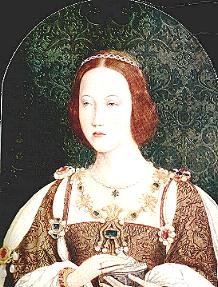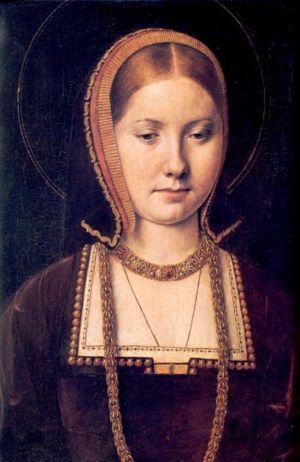| Mary (Tudor) Brandon is managed by the England Project. Join: England Project Discuss: england |
Contents |
Biography
Mary Tudor was the youngest daughter of King Henry VII of England. She became Queen of France at her marriage to King Louis XII, and after his death, she married Charles Brandon, 1st Duke of Suffolk.
Mary Tudor was the fifth child of Henry VII of England and his queen Elizabeth of York, and their youngest surviving daughter. to survive infancy. She thus became the youngest sister of King Henry VIII. She was born about 18 March 1495/6 at Richmond Palace. [1]
Marriage to France
Mary was from all accounts a particularly beautiful girl, and in 1507 she was betrothed by her father to Charles of Castile (also of Burgundy and of Austria), grandson of Holy Roman Emperor Maximilian (he would become Emperor Charles V) - a boy about four years her junior. [2] This marriage was celebrated by proxy at Richmond on 17 December 1508, after which Mary was styled "Princess of Castile." [3] [4] [5] In sealing the betrothal, Henry made Charles a Knight of the Garter on 20 December 1508.[6]
In 1509, Henry VIII succeeded to the throne of England and decided to make war on France, in which he joined Pope Julius II, his father-in-law Ferdinand of Aragon and the Emperor Maximilian. However, in 1514, when the marriage of Mary and Charles was scheduled to be made official, Charles then coming of age, Maximilian decided to make a separate peace with France, following the election of a new Pope, who also pressed Henry to make peace. Repudiating the marriage to Charles, Henry instead married his sister to the moribund Louis XII of France.[7] [4] [5]
Mary was greatly distressed at this abrupt change of plans, and she is said to have agreed to the marriage only on the condition that she be allowed to take a husband of her own choice after the death of Louis - which was indeed imminent.[5] [8] She was married by proxy, first at Greyfriars Church Greenwich on 13 August, secondly, again by proxy, on 2 September at the Church of the Celestines in Paris, and finally in person on 9 October at Abbeville Cathedral, after which Louis dismissed all her English attendants. She was crowned 5 November at St Denis's Cathedral in Paris, after which there were weeks of jousting in her honor. [1] [4] [9]
Marriage to Suffolk
On 1 January, Louis XII died, leaving his new queen a widow. Mary was now in a desperate position, as she feared with good reason that both the new king of France, Francis I, and her brother Henry might attempt to marry her off to another suitor. At stake was the large fortune she had brought to France as her dowry; Henry wanted it back.[10] [11] Henry's favorite companion, Charles Brandon, Duke of Suffolk, was sent to retrieve both widow and fortune, but instead he ended up marrying her himself. The precise course of events is disputed. The official story is that Mary pressed Suffolk to marry her to keep her from a worse fate; Suffolk told Henry, "I newar sawe woman soo wyepe."[12] They were remarried on 13 March 1515 in Greenwich, in the presence of witnesses from the English court. But it was an expensive marriage, as the Suffolks had to bind themselves to repay Henry the vast sum of the dowry, including plate and jewels, all left in France. This debt would hang over the family for the rest of their lives.[4] [5][13]
For the next decade, Mary, still known as "the French Queen", divided her time between the splendors of her brother's court and the quiet of the Suffolk estates, notably his seat of Westhorpe Hall. The marriage appears to have been a fond one; letters testify to the unwillingness of husband and wife to be parted for long.[14] In 1520, they both played prominent roles at the extravagant pageant known as the Field of the Cloth of Gold, at which the kings of England and France competed to see which one could exceed the other in expenditure.[15]
During this period, Mary gave birth to the following children: [1]
- Henry Brandon, b. 11 Mar 1515/16, d. before 1522
- Lady Frances Brandon b. 16 Jul 1517, d. 20 Nov 1559
- Lady Eleanor Brandon b. 1519/20, d. 27 Sep 1547
- Henry Brandon b. 1522, d. Mar 1533/4 1st Earl of Lincoln 1525
When at court, Mary became increasingly close to her sister-in-law, Catherine of Aragon. In 1525, her son Henry, second of his name, was created 1st Earl of Lincoln.[16] But after that year relations became increasingly strained as King Henry grew distant from his wife and turned toward one of his ladies-in-waiting, Anne Boleyn. The Suffolks, Mary in particular, took the side of Catherine as the pressure from the king to divorce his wife intensified.[17] At this time, in 1528, the insecurity this caused in Mary caused her to insist that her husband obtain a Papal Bull to confirm the invalidity of one of his prior marriages, to Margaret Neville, Lady Mortimer.[18]
Mary died at Westhorpe Hall, Westhorpe, Suffolk on June 25, 1533, and on 21 July had a magnificent funeral, befitting a queen.[19] [20]Her coffin bore her personal motto: "La Volonté de Dieu me suffit." She was initially buried at the abbey of Bury St Edmunds, but after Henry VIII's dissolution of the monasteries, her body was moved to nearby St. Mary's Church.
In September, Charles Brandon married their son's fiancée, who was also his ward, fourteen-year-old Catherine Willoughby, by whom he had two sons, who briefly succeeded to the Dukedom.[21]
Sources
- ↑ 1.0 1.1 1.2 Alison Weir, Britain's Royal Family: A Complete Genealogy, p. 152. London: VIntage Books, 2008.
- ↑ "Henry VIII: September 1509." Letters and Papers, Foreign and Domestic, Henry VIII, Volume 1, 1509-1514. Ed. J S Brewer. London: His Majesty's Stationery Office, 1920. 82-97. British History Online. Web. 8 March 2021. BHO
- ↑ Scarisbrick, J. J. 'Henry VIII.' p. 40. London : Eyre & Spottiswoode, 1968.
- ↑ 4.0 4.1 4.2 4.3 Dictionary of National Biography, 1885-1900, Volume 36: Mary (1496-1533), by James Gairdner DNB
- ↑ 5.0 5.1 5.2 5.3 1911 Encyclopædia Britannica, Volume 17: Mary, queen of France. Britannica
- ↑ Shaw, Knights of England, vol 1. p. 18. Knights
- ↑ Scarisbrick, pp. 50- 54.
- ↑ Green, Mary Anne Everett. Lives of the Princesses of England, From the Norman Conquest. Vol V. p. 29. London: Longman, Brown, Green, Longman, & Roberts, 1857. Green
- ↑ "Henry VIII: September 1514, 16-30," in Letters and Papers, Foreign and Domestic, Henry VIII, Volume 1, 1509-1514, ed. J S Brewer (London: His Majesty's Stationery Office, 1920), 1385-1401. British History Online, accessed December 25, 2020, BHO
- ↑ Green, p. 76. Green
- ↑ Scarisbrick, p. 57.
- ↑ Gunn, Steven. Charles Brandon. pp. 49-52. Amberley Publishing, 2016.
- ↑ Edward Walford. "Greenwich," in Old and New London: Volume 6, (London: Cassell, Petter & Galpin, 1878), 164-176. British History Online, accessed November 15, 2021, http://www.british-history.ac.uk/old-new-london/vol6/pp164-176.
- ↑ Green, p. 109 ff. Green
- ↑ Chronicles of Calais Chronicle of Calais Page 77 Field of the Cloth of Gold
- ↑ Hall's Chronicle. p. 703. Hall's Chronicle
- ↑ Green, p, 136-138. Green
- ↑ Green, p. 137. Green
- ↑ Gunn, 143-144.
- ↑ Green, pp. 138-141. Green
- ↑ Gunn, p. 146.
- Royal Ancestry by Douglas Richardson Vol. V page 208
- Royal Ancestry D. Richardson 2013 Vol. I pp.507-509
- Charles Mosley, editor, Burke's Peerage, Baronetage & Knightage, 107th edition, 3 volumes (Wilmington, Delaware, U.S.A.: Burke's Peerage (Genealogical Books) Ltd, 2003), volume 1, page 1064. Hereinafter cited as Burke's Peerage and Baronetage, 107th edition.
- Wikipedia: Mary Tudor
- [S3409] Caroline Maubois, "re: Penancoet Family," e-mail message to Darryl Roger Lundy, 2 December 2008. Hereinafter cited as "re: Penancoet Family."
- Sadlack, Erin A. "Literary Lessons in Queenship and Power: Mary Tudor Brandon and the Authority of the Ambassador-Queen". In Women and Power at the French Court, 1483-1563, edited by Broomhall Susan, 117-38. Amsterdam: Amsterdam University Press, 2018. Accessed January 17, 2021. https://www.jstor.org/stable/j.ctv8pzd9w.7. (no access 3/9/21)
- Harris, Barbara J. “Power, Profit, and Passion: Mary Tudor, Charles Brandon, and the Arranged Marriage in Early Tudor England.” Feminist Studies 15, no. 1 (1989): 59–88. https://doi.org/10.2307/3177818.
No known carriers of Mary's DNA have taken a DNA test. Have you taken a test? If so, login to add it. If not, see our friends at Ancestry DNA.
 Phil Jourdeuil
Phil Jourdeuil
 Ros Haywood
Ros Haywood
 Scott Hutchins
Scott Hutchins
This week's featured connections are French Notables: Mary is 12 degrees from Napoléon I Bonaparte, 13 degrees from Gilbert du Motier de La Fayette, 16 degrees from Sarah Bernhardt, 20 degrees from Charlemagne Carolingian, 22 degrees from Sidonie-Gabrielle Colette, 17 degrees from Pierre Curie, 25 degrees from Simone de Beauvoir, 17 degrees from Philippe Denis de Keredern de Trobriand, 13 degrees from Camille de Polignac, 13 degrees from Henri-Gustave Joly de Lotbinière, 18 degrees from Claude Monet and 12 degrees from Aurore Dupin de Francueil on our single family tree. Login to see how you relate to 33 million family members.
T > Tudor | B > Brandon > Mary (Tudor) Brandon
Categories: This Day In History June 25 | This Day In History March 18 | Edward III 6th Gen Descendants | Field of the Cloth of Gold | House of Tudor




